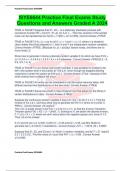Practice Final Exams ISYE6644
ISYE6644 Practice Final Exams Study
Questions and Answers Graded A 2024
TRUE or FALSE? Suppose that X1, X2,... is a stationary stochastic process with
covariance function Rk = Cov(X1, X1+k), for k=0,1,... Then the variance of the sample
mean can be represented as Var(X) = 1/n[Ro + 2(1-k/n)Rk] -Correct Answer ✔TRUE
TRUE or FALSE? If f(x, y) = cxy for all 0 < x < 1 and 1 < y < 2, where c is whatever
value makes this thing integrate to 1, then X and Y are independent random variables. -
Correct Answer ✔TRUE. (Because f(x, y) = a(x)b(y) factors nicely, and there are no
funny limits.) 2
Show how to generate in Arena a discrete random variable X for which we have Pr(X =
x) = 0.3 if x = −3 0.6 if x = 3.5 0.1 if x = 4 0 otherwise. -Correct Answer ✔DISC(0.3, −3,
0.9, 3.5, 1.0, 4)
TRUE or FALSE? In our Arena Call Center example, it was possible for entities to be
left in the system when it shut down at 7:00 p.m. (even though we stopped allowing
customers to enter the system at 6:00 p.m.). -Correct Answer ✔True - because of the
small chance that a callback will occur.
TRUE or FALSE? An entity can be scheduled to visit the same resource twice, with
different service time distributions on the two visits! -Correct Answer ✔TRUE
TRUE or FALSE? Arena has a built-in Input Analyzer tool that allows for the fitting of
certain distributions to data. -Correct Answer ✔TRUE
Suppose the continuous random variable X has p.d.f. f(x) = 2x for 0 ≤ x ≤ 1. Find the
inverse of X's c.d.f., and thus show how to generate the RV X in terms of a Unif(0,1)
PRN U. -Correct Answer ✔X=sqrt(U)
The c.d.f. is easily shown to be F(x) = x 2 for 0 ≤ x ≤ 1, so that the Inverse Transform
Theorem gives F(X) = X2 = U ∼ Unif(0, 1). Solving for X, we obtain the desired inverse,
F −1 (U) = X = √ U, where we don't worry about the negative square root, since X ≥ 0.
Thus, (d) is the answer.
If U1 and U2 are i.i.d. Unif(0,1) with U1 = 0.45 and U2 = 0.45, use Box-Muller to
generate two i.i.d. Nor(0,1) realizations. -Correct Answer ✔Z1 = -1.2019, Z2 = 0.3905
Suppose that Z1, Z2, and Z3 are i.i.d. Nor(0,1) random variables, and let T = Z1 /sqrt((Z
2 2 + Z 2 3 )/2) . Find the value of x such that Pr(T < x) = 0.99. -Correct Answer
✔x=6.965
Practice Final Exams ISYE6644
, Practice Final Exams ISYE6644
Suppose X has the Laplace distribution with p.d.f. f(x) = λ/2 e^−λ|x| for x ∈ R and λ > 0.
This looks like two exponentials symmetric on both sides of the yaxis. Which of the
methods below would be very reasonable to use to generate realizations from this
distribution? -Correct Answer ✔Inverse Transform Method AND Acceptance-Rejection
Consider a bivariate normal random variable (X, Y ), for which E[X] = −3, Var(X) = 4,
E[Y ] = −2, Var(Y ) = 9, and Cov(X, Y ) = 2. Find the Cholesky matrix associated with (X,
Y ), i.e., the lower-triangular matrix C such that Σ = CC0 , where Σ is the variance-
covariance matrix. -Correct Answer ✔C = (2 0
1 2sqrt(2))
Consider a nonhomogeneous Poisson arrival process with rate function λ(t) = 2t for t ≥
0. Find the probability that there will be exactly 2 arrivals between times t = 1 and 2. -
Correct Answer ✔0.224
Suppose we are generating arrivals from a nonhomogeneous Poisson process with rate
function λ(t) = 1 + sin(πt), so that the maximum rate is λ ? = 2, which is periodically
achieved. Suppose that we generate a potential arrival (i.e., one at rate λ ? ) at time t =
0.75. What is the probability that our usual thinning algorithm will actually accept that
potential arrival as an actual arrival? (Note that the π means that calculations are in
radians.) -Correct Answer ✔0.854
Suppose X1, X2, . . . is an i.i.d. sequence of random variables with mean µ and
variance σ 2 . Consider the process Yn(t) ≡ Pbntc i=1 (Xi − µ)/(σ √ n) for t ≥ 0. What is
the asymptotic probability that Yn(4) will be at least 2 as n becomes large? Hint: Recall
that Donsker's Theorem states that Yn(t) converges to a standard Brownian motion as n
becomes large. -Correct Answer ✔0.1587
Which one of the following properties of a Brownian motion process W(t) is FALSE? -
Correct Answer ✔W(3) − W(1) is independent of W(4) − W(2).
Find the sample variance of −10, 10, 0. -Correct Answer ✔100
S^2 = 100
If X1, . . . , X10 are i.i.d. Exp(1/7) (i.e., having mean 7), what is the expected value of
the sample variance S 2 ? -Correct Answer ✔49
S^2 is always unbiased for the variance of Xi. Thus, we have E[S^2] = Var(Xi) =
1/lambda^2 = 49.
TRUE or FALSE? The mean squared error of an estimator is the square of the bias plus
the square of its variance -Correct Answer ✔False
If X1 = 7, X2 = 3, and X3 = 5 are i.i.d. realizations from a Nor(µ, σ2 ) distribution, what is
the value of the maximum likelihood estimate for the variance σ 2 ? -Correct Answer
✔2.667
Practice Final Exams ISYE6644




